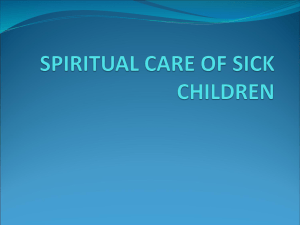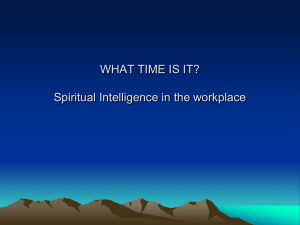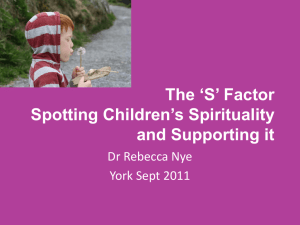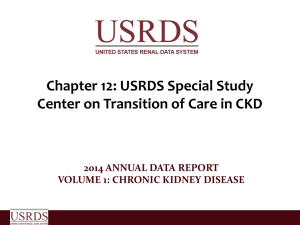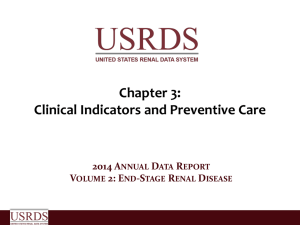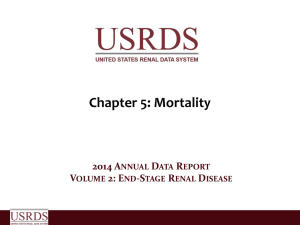The influences of spirituality on well-being and health
advertisement
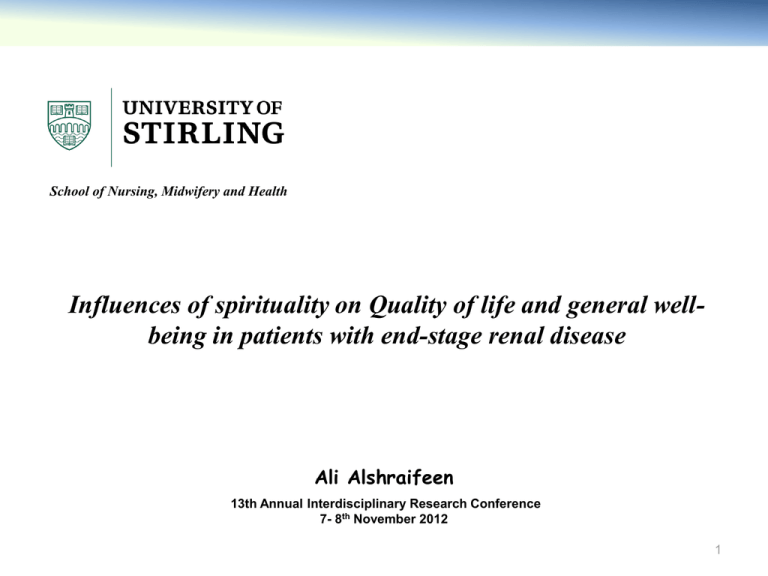
School of Nursing, Midwifery and Health Influences of spirituality on Quality of life and general wellbeing in patients with end-stage renal disease Ali Alshraifeen 13th Annual Interdisciplinary Research Conference 7- 8th November 2012 1 Outline: 1. Background • General • ESRD in Scotland • Difficulties facing ESRD patients 2. Justification 3. Study aims 4. Method • Quantitative • Qualitative 5. Results 6. Summary 2 Background Chronic illness: physical or mental conditions that affect the daily functioning of individuals for intervals >3 months/year, or for a duration of hospitalisation >1 month (Theofanidis 2007) Chronic illness has significant physical, psychological, social, economical, and spiritual effects on the individual (Delaney 2005) ESRD: a long term condition to both kidneys, it is debilitating and progressive Kidneys are unable to remove metabolic waste products from the body (Tanyi & Werner 2003) ESRD: patients need to start renal replacement therapy (HD, PD, RX) (http://www.kidney.org) HD is the most commonly used method of treatment (National Kidney Foundation) 3 3 ESRD in Scotland First patient dialysed in Scotland in 1960 December 2010: 13506 accepted for renal replacement therapy (RRT): HD, PD, and kidney transplantation (SRR, 2010) The number of prevalent patients is still rising; increasing cost of treatment, pressure on patient, staff, and the NHS 4 Difficulties facing patients with ESRD Physical (reduced mobility, fatigue, joint pain, site infection, cardiovascular) Psychological ( depression, anxiety, low self esteem) Social (loss of role and identity) Logistic (fluid and diet restrictions, no choice of treatment) Spiritual (inability to practice beliefs, fulfil spiritual needs, feeling tested) Together = poorer quality of life/ well-being 5 Justification of the study Interest in studying spirituality increasingly emerging in the literature Spirituality: important aspect of health and well-being in people with chronic health conditions (Parsian & Dunning 2009) Higher levels of spiritual health may lead to an improved quality of life and coping (Morrison 2005) Providing spiritual care may lead to an improved coping with the various challenges facing patients with chronic illnesses (Yao 2009) Is spirituality linked with health outcomes in patients with chronic illness (ESRD)? 6 Why ESRD… Minimal information in the literature linking spirituality and the needs of patients with ESRD There is a lack of research addressing spirituality and its contribution to adjustment in patients with ESRD (Tanyi &Werner 2003) Study aims To investigate the influences of ESRD on patients’ quality of life (QoL) and general well-being To examine the factors that can affect these influences (age, gender, hope, social support) To examine the relationship between spirituality and the QoL and general well-being of patients with ESRD Spirituality framework Spiritual health: a fundamental dimension of people’s overall health and well-being (physical, mental, emotional, social, and vocational) Fisher’s (1998) spiritual well-being model : • Personal domain • Communal domain • Environmental domain • Transcendental domain Cross-sectional survey (May 2009- May 2010) Quantitative Questionnaires 72 participants Study Design Grounded theory Qualitative December 2011ongoing 30 participants In-depth interviews 10 Quantitative Cross-sectional survey (questionnaires) Quality of life Measure (SF-36v2): validated by analysing the scores from patients with 25 different health conditions General health questionnaire (GHQ-28): to measure depression, anxiety and insomnia, social dysfunction, and coping The multidimensional scale of perceived social support (MSPSS) Herth hope index (HHI) The spiritual well-being questionnaire (SWBQ) The brief COPE scale to assess patients’ coping with stressful events Participants All ESRD patients in 5 Health Boards in Scotland (800 participants) eligible Estimated number of distributed study packs (364, 45.5% of the total sample) Number of completed questionnaires (n=72) Inclusion criteria: • ESRD patients/on HD • On dialysis ≥6 months • English speaking • >18 years old Exclusion criteria: • Distressed patients • Psychological, neurological, or communication problems 12 Data analysis and results Data analysis (PASW 18) Results • Overall response rate (19.8%) out of estimated 364 • 50% of the sample were 56 years and older (n=36) • Majority were retired (n=49) • Majority were on HD for 6months- 5 years (n=44) • Majority lived with families (n=46) • More males (56.9%) 13 Quality of life Quality of life domains Mean score Standard Deviation Physical Functioning 25.75 12.61 Role Physical 26.24 11.48 Bodily Pain 33.19 11.52 General Health 43.22 6.04 Vitality 47.62 6.78 Social Functioning 36.27 5.28 Role Emotion 35.66 15.59 Mental Health 43.66 6.07 MCS 47.84 7.52 PCS 26.53 7.26 Patients quality of life Patients scored considerably less than the UK population average norms Most affected domains of QoL were the physical domains (PF, RP, BP, PCS) and SF, and RE Scores on the Vitality, Mental Health and overall MCS were close to general population average 15 Demographics and quality of life PF RP BP GH VT SF MH MCS PCS R=-.237* R=-.094 R=-.052 R= -.111 R=.024 R=.067 R= .169 R= .234* R=-.343** p=.045 p=.430 p=.665 p=.351 p=.842 p=.579 p=.157 p=.048 p=.003 R= -.183 R=.-070 R= .113 R=-.089 R= .108 R=.082 R=-.007 R=-.083 R= -.135 p=.123 p=.557 p=.346 p=.458 p=.368 p=.495 p=.950 p=.480 p=.258 Living R=-.025 R= .174 R=.037 R=.041 R= -.120 R= 113 R=-.090 R= -.112 R= .133 alone p=.837 p=.144 p=.758 p=.735 p=.314 p=.346 p=.451 p=.348 p=.267 Working R= -.192 R= -.119 R= .150 R=-.035 R= -.112 R= 133 R= .112 R= .107 R= -.162 status p=.107 p=.319 P=.209 p=.771 p=.350 p=.264 p=.350 p=.369 p=.173 R=.058 R= .134 R= .139 R=-.067 R=.086 R= .159 R=.091 R=.055 p=.628 p=.263 p=.246 p=.577 p=.473 p=.181 p=.445 p=.644 Age Gender Period on R=-.036 dialysis p=.765 **P< 0.01 (1-tailed), * P< 0.05 (2-tailed), PF (physical functioning), RP (role physical), BP (bodily pain), GH (general health), VT (vitality), RE (role emotion), SF (social functioning), MH (mental health), MCS (mental component summary scores), PCS ((physical component summary scores) 16 Demographics and well-being Socio-demographic characteristics General well-being Age R= -.292* (p=.013) Gender R= .297* (p=.011) Living status R= .192 Working status R= -.043 (p=.721) Period on dialysis R= -.179 (p=.133) (p= .107) 17 Demographics and quality of life and well-being Pearson product moment correlation was conducted between sociodemographic characteristics and the SF-36 domains and patients wellbeing Age associated negatively with the overall PCS (r= -.343**, p=.003) and Physical Functioning domain (r= -.237*, p=.045) Age positively associated with the overall MCS (r= .234*, p=.048) Age associated negatively with general well-being (r= -.292*, p=.013) Gender associated positively with general well-being(r=.297, p=.011) 18 Spirituality and quality of life Scale MCS PCS Spiritual well-being total score R= .013 (p= .911) R= .119 (p= .321) Importance of religion in your life R= .229 (p= .053) R= -.094 (p= .432) Importance of spirituality in your life Frequency of church/religious group attendance (apart from weddings or funerals) R= .131 (p= .272) R= .013 (p= .911) R= .157 (p= .189) R= -.049 (p= .681) Frequency of prayer R= .101 (p= .398) R= .057 (p= .635) 19 Spirituality and quality of life Borderline significant associations between the importance of religion in patients lives and SF (R= .226, p= .057)and MCS (R= .229, p= .053) Total Religion subscale (Brief COPE) associated positively with the overall MCS score (r=.231, p=.051), indicating that more use of religion associated with better mental health No significant correlations between spirituality and patient’s general well-being 20 Summary Patients with ESRD reported a marked decrease in all domains of QoL, mainly (PF, RF, BP, GH and PCS) compared to the UK general population MCS & Vitality scores were very close to the general population norms Increasing age associated with reduced physical functioning; however better mental health and general well-being Females reported worse general well-being Importance of religion associated with better mental health and social functioning No significant associations between spirituality and general well-being 21 References • • • • • • • • • Delaney, C. (2005) the spirituality scale: development and psychometric testing of a holistic instrument to assess the human spiritual dimension. Journal of Holistic Nursing. vol. 23, pp. 145-167 Fisher, J (1998) spiritual health: its nature and place in the school curriculum. PhD thesis. The University of Melbourne Morrison, D. (2005) nephrology nursing: spirituality and tough nursing. Canadian Association of Nephrology Nurses and Technicians (CANNT). Conference presentation National Kidney Foundation. Available online: http://www.kidney.org. Parsian, N., Dunning, T., (2009) developing and validating a questionnaire to measure spirituality: a psychometric process. Global Journal of Health Science. vol.1(1), pp.2-11 Scottish Renal Registry, (November 2003). [Online] available from http://www.srr.scot.nhs.uk Tanyi, R., Werner, J., (2003) adjustment, spirituality, and health in women on haemodialysis. Clinical Nursing Research. vol. 12(3), pp.229-245 Theofanidis, D. (2007) chronic illness in childhood: psychosocial adaptation and nursing support for the child and family. ICUS and Nursing Web Journal. Vol. 29-30 Yao, C. (2009) spiritual care in palliative care team. Conference presentation at the 24th General Conference of the World Fellowship of Buddhists Symposium on Buddhist Wisdom in Caring for the Dying and Bereaved 22 Any questions ? 23


